Project Update: Field Trips Wrap Up Another Successful Year of GEAR UP Partnership
Starting a collaborative community and citizen science project with high schools is no small feat. Try starting it during the pandemic. That’s what we did with the Center’s collaboration with GEAR UP STEM Rural Valley Partnership Spinning Salmon in the Classroom project. After managing a year of distance learning in 2021 and piloting in-person content in 2022, we had so much we were excited to do this year.
One aspect of the project we wanted to further develop was our field trip options. We designed robust field trips that provided an opportunity for students to deepen content learning, engage with the research team, and connect to organizations and agencies working to protect salmon within their local watershed.
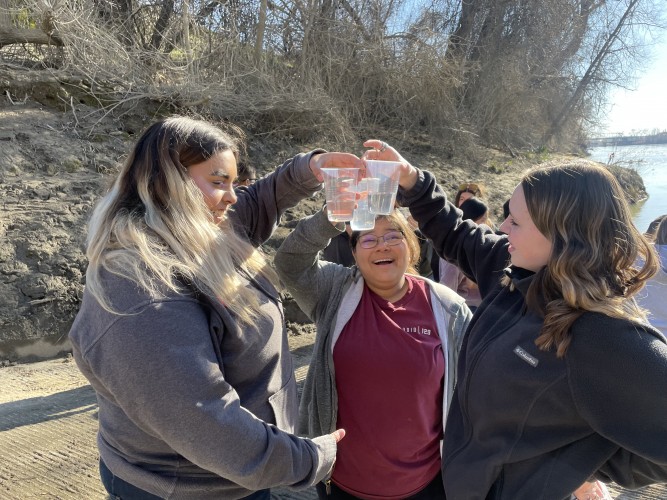 After starting the project with
virtual field trips, this year all 6 schools went on a field
trip! Through GEAR UP advisors, teachers were offered the
opportunity to release salmon raised in the classroom in the
Feather River, get a behind-the-scenes tour of the Feather
River Fish Hatchery, or observe restoration in action at the
Dye Creek Preserve. Read more about fish release and hatchery
field trips
in our blog.
After starting the project with
virtual field trips, this year all 6 schools went on a field
trip! Through GEAR UP advisors, teachers were offered the
opportunity to release salmon raised in the classroom in the
Feather River, get a behind-the-scenes tour of the Feather
River Fish Hatchery, or observe restoration in action at the
Dye Creek Preserve. Read more about fish release and hatchery
field trips
in our blog.
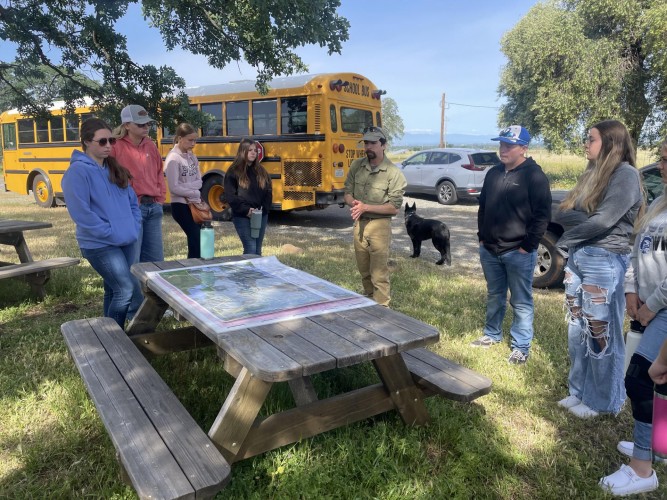 Our final field trip of the season
was co-developed with The Nature Conservancy and the Resource
Conservation District of Tehama County (RCD). Students
from Orland High School began the field trip at the Dye
Creek Preserve headquarters. Using maps, Preserve staff
oriented students to the Preserve’s location, highlighting
the creeks they would explore during the day, their headwaters,
and where they connected to the Sacramento River. This served
as context for explaining the importance of the Preserve’s
creeks to the Chinook salmon life cycle, connecting this local
watershed to the river where students released their fish into
back in February.
Our final field trip of the season
was co-developed with The Nature Conservancy and the Resource
Conservation District of Tehama County (RCD). Students
from Orland High School began the field trip at the Dye
Creek Preserve headquarters. Using maps, Preserve staff
oriented students to the Preserve’s location, highlighting
the creeks they would explore during the day, their headwaters,
and where they connected to the Sacramento River. This served
as context for explaining the importance of the Preserve’s
creeks to the Chinook salmon life cycle, connecting this local
watershed to the river where students released their fish into
back in February.
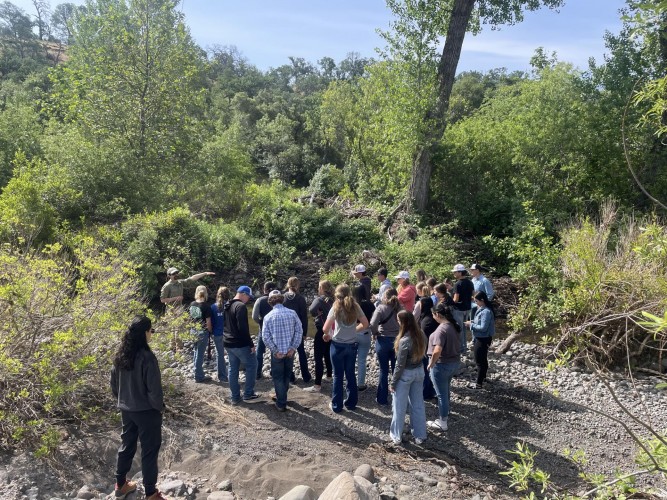 At the headquarters, students saw
the seasonal Dye Creek’s riparian zone. They discussed with staff
how the shady plants, complex riverbed, floodplains, and pools
they observed could all serve as supportive salmon
habitat. They observed the high water mark and discussed how
water availability impacts the use of the creek by salmon
year-to-year.
At the headquarters, students saw
the seasonal Dye Creek’s riparian zone. They discussed with staff
how the shady plants, complex riverbed, floodplains, and pools
they observed could all serve as supportive salmon
habitat. They observed the high water mark and discussed how
water availability impacts the use of the creek by salmon
year-to-year.
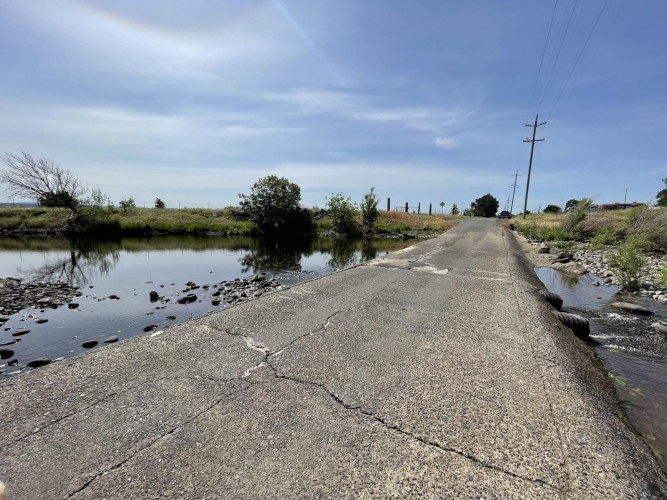 On the drive down from the Preserve
headquarters, we all made a stop on Shasta Boulevard to the
site of the RCD’s ongoing
fish passage restoration project on Dye Creek. The RCD’s
project manager met us at the site to tell us about all the steps
involved in planning for improvements to this road that
will not only benefit fish, but human safety as well. This
was a great opportunity to learn about what it takes to
collaborate with different groups and think through the different
skills involved in a project like this one.
On the drive down from the Preserve
headquarters, we all made a stop on Shasta Boulevard to the
site of the RCD’s ongoing
fish passage restoration project on Dye Creek. The RCD’s
project manager met us at the site to tell us about all the steps
involved in planning for improvements to this road that
will not only benefit fish, but human safety as well. This
was a great opportunity to learn about what it takes to
collaborate with different groups and think through the different
skills involved in a project like this one.
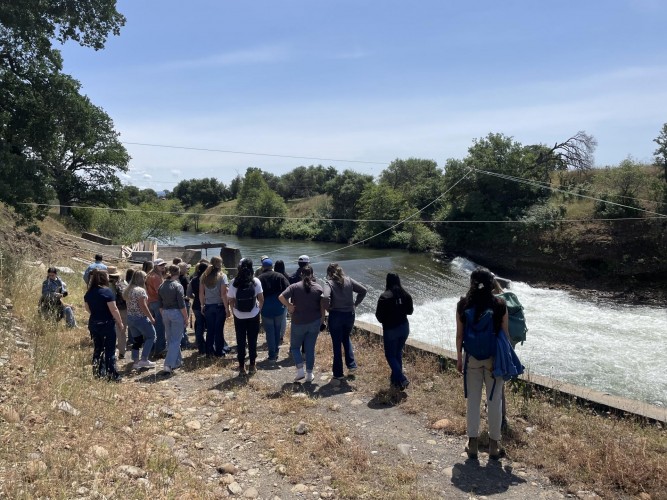 From there, we went on a hike to see
Mill Creek. This creek was a stark comparison to Dye Creek.
Students observed the change in water velocity, temperature, and
habitat complexity between locations. Mill Creek is
channelized with steep banks that lack riparian plants, but sees
more salmon than Dye Creek. We saw how the large
infrastructure, including a diversion dam and screw trap,
are used to support salmon. Students were able to observe
these differences and think through the pros and cons of each,
including why salmon might use one creek over the other.
From there, we went on a hike to see
Mill Creek. This creek was a stark comparison to Dye Creek.
Students observed the change in water velocity, temperature, and
habitat complexity between locations. Mill Creek is
channelized with steep banks that lack riparian plants, but sees
more salmon than Dye Creek. We saw how the large
infrastructure, including a diversion dam and screw trap,
are used to support salmon. Students were able to observe
these differences and think through the pros and cons of each,
including why salmon might use one creek over the other.
Throughout the field trip, Nature Conservancy and RCD staff discussed different related career paths and classroom connections. We had a fantastic mix of folks – from recent college graduates, AmeriCorps members, retired US Fish and Wildlife Service biologists, trailworkers, services workers, to engineers - all talk about how they ended up in careers outdoors.
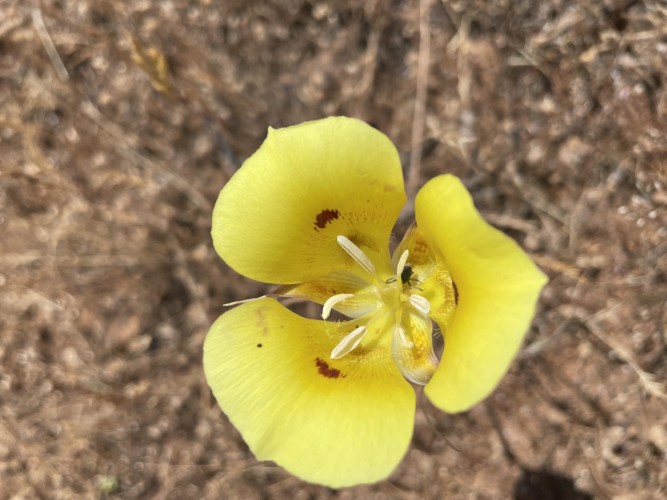 On top of all that, we lucked out
with the weather and the amazing display of wildflowers!
On top of all that, we lucked out
with the weather and the amazing display of wildflowers!
It was wonderful to work with the Preserve and RCD to co-develop this field trip. It was a special experience for students to connect the Spinning Salmon project content locally and meet organizations active in supporting salmon. We’re already thinking about ideas for next year’s field trips!








